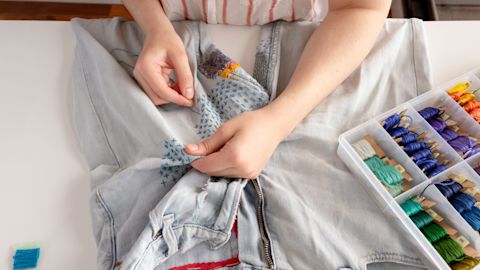We know our fashion choices are hurting the planet.
But style shouldn’t cost the earth. Prolonging the life of our clothes, and disposing of them correctly when we’re done, can go a long way towards addressing the problem.
If you have garments in excellent condition you once loved but no longer wear, bring them to our Tramsheds clothes swap on Saturday 13 December. You can refresh your wardrobe and pick up to 5 preloved pieces brought by fellow swappers. It’s free for City of Sydney residents, but spaces are limited.
Store and protect your clothes
A little care can go a long way and save you big money in the long run. Investing in shoe conditioners or leather protectors are easy ways to prolong your favourite shoes.
Put expensive items in cotton suit bags to avoid moth damage. You can repurpose an old sheet by cutting a hole in the top for a coat hanger to come through and sew the sides for a DIY suit bag.
Wash with care
Extend the life of your clothes by following the care instructions on their label. Different types of fabric need different amounts of care. Otherwise you might find your favourite shirt has shrunk after a few washes.
In the video below, Leah Giblin, creator of clothing label Day Keeper, covers which fabrics to buy and avoid, how to reduce the impact of polyester and caring for natural fibres.
A pretty good rule of thumb is to wash clothes in cooler temperatures. It’s kinder on the fabric and more energy efficient.
Make sure you zip up and button all items to stop clothes getting snagged in the washing machine. Delicate washing bags will help keep your intimates extra safe.
If your clothes or towels need a fabric softener, consider using vinegar as an alternative. This helps remove build up from detergents and soften rough items. In return, vinegar can also help clean your washing machine drum in removing soap scum, mineral build-up and odours. Talk about hitting 2 birds with one stone.
Skip the dryer and try air drying. Hanging clothes in indirect sunlight can help you avoid unwanted shrinking, minimise wear and tear and reduce your energy bills. If you need the extra sun but worried about colour fading, turn items inside out when hanging them in the sun to dry.
Consider whether you need to wash an item in the first place. Clothes don’t always need to be washed after every wear. Try refreshing your clothes without washing. A spot wash can help address small spills and stains.
Mend, repair or repurpose
A ripped or torn piece of clothing is a sign that it’s well-loved, not that it needs to be tossed. Even if an item has a hole or tear, the fabric likely still has a lot of life in it.
Take damaged clothing or shoes to your local tailor or repairer. The cost to repair is often a fraction of the price of buying something new.
You can also try repairing it yourself. Bring your latest sewing project to a social sewing session at Reginald Murphy Community Centre in Potts Point or a makers' morning social craft group at St Helen’s Community Centre in Glebe.
By keeping your clothes in active use for an extra 9 months, you can help reduce their carbon, water and waste footprints by 20-30%.
Mending isn’t just about fixing an item, it can make it even better. Visible mending techniques, like elbow patches, can bring new life to old clothes, with no sewing machine needed.
If something can’t be fixed, you could cut it up and use the fabric for rags or to patch up a hole in something else.
Watch the video below for tips about upcycling old clothes. Learn how to refresh a stained shirt, turn an old tee into a pillowcase and transform socks into heat packs.
Closing the loop on clothes
Even when your clothes reach the end of their life, they still hold value. By recycling your worn-out clothes and textiles through Recycle It Saturday, Ultimo recycling pop-up and doorstep recycling service, your small actions can make a big difference in diverting precious materials from landfill.
Published 13 April 2022, updated 13 November 2025



